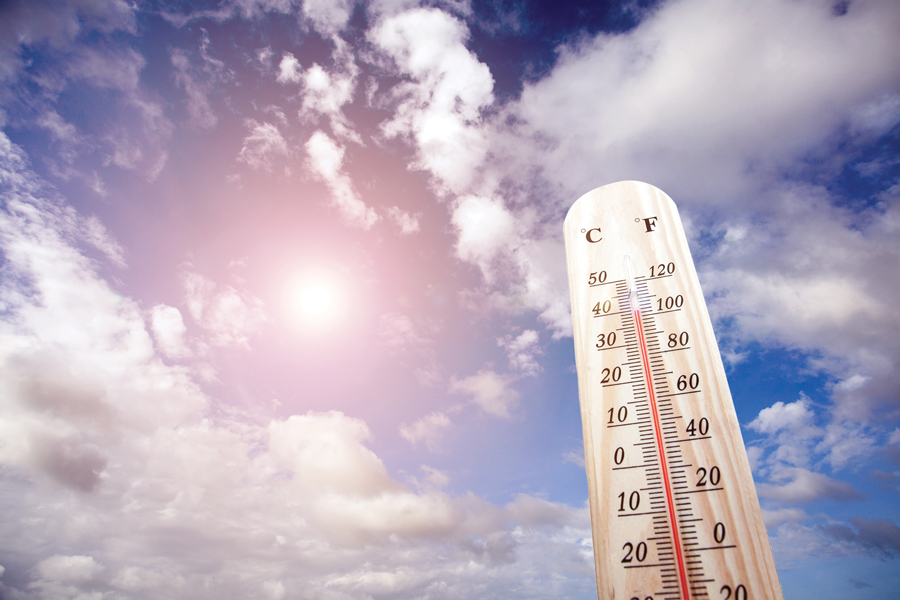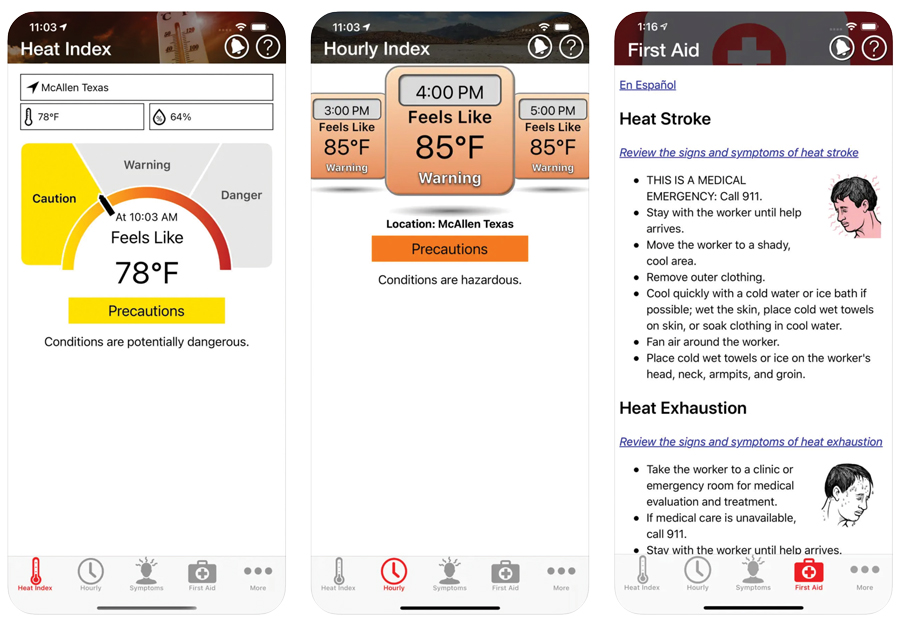The United States Occupational Safety and Health Administration (OSHA) has launched a new national emphasis program (NEP) to help prevent heat-related illnesses at outdoor and indoor workplaces, including electrical contractors and other wiring installation contractors (2017 NAICS Code 2382).
The program, CPL 03-00-024 Outdoor and Indoor Heat-Related Hazards, was announced by Labor Secretary Marty Walsh with Vice President Kamala Harris at a union training center in Philadelphia.
The most important part of the program is that it targets specific industries and activities, such as working outdoors in areas announced by the National Weather Service (NWS) to be undergoing a heat wave, or working indoors near radiant heat sources, such as foundries.
CHANGES IN INSPECTION PROCEDURES
The NWS issues a heat advisory within 12 hours of the onset of extremely dangerous heat. The general rule of thumb for this advisory is that the maximum heat index is expected to be 100°F or higher for at least two days, and nighttime air temperatures will not drop below 75°F.
Programmed Inspections
Under the program, OSHA will conduct, in certain outdoor and indoor workplaces, programmed inspections on any day for which the National Weather Service has announced a heat warning or advisory in the local area. Those workplaces include the high-hazard industries named in Appendix A to the program, including electrical contracting and other industries in which NETA members operate.
Non-Programmed Inspections
Even if an employer is not covered by the NEP because it is not in the listed high-hazard industries, it could still face an inspection under the NEP. The program requires OSHA inspectors conducting an investigation or inspection not related to heat hazards to open a heat-related inspection if a hazardous heat condition is recorded in an OSHA 300 log or 301 incident report, or if an employee brings a heat-related hazard to the inspector’s attention.
The program will also require inspectors to ask during non-heat inspections whether the employer has a heat-related hazard prevention program that applies when the heat index for the day is expected to be 80°F or more.
The NEP requires each OSHA regional office to double its number of heat-related inspections.
For example, an inspection following a hospitalization for an arc flash injury in March in Tampa, Florida, would probably expand into a heat-related inspection based just on the heat index.
Heat-Related Inspection
During heat-related inspections, the program requires OSHA compliance safety and health officers (CSHOs) to:
- Review OSHA 300 logs and 301 incident reports for evidence of heat-related illnesses.
- Review records of heat-related emergency room visits or ambulance transport.
- Interview workers for symptoms of headache, dizziness, fainting, dehydration, or other indicia of heat-related illnesses.
- Document the existence of conditions, such as high temperature, that cause heat-related hazards.
- Determine whether the employer has a heat illness and injury program, including whether:
- The employer has a written program.
- The employer monitors temperature and worker exertion.
- Unlimited cool water is easily accessible to workers.
- Hydration breaks are required.
- New and returning workers are provided time for acclimatization.
- Rest breaks are scheduled.
- Workers have access to a shaded area.
- A buddy system is in place on hot days.
- Work is scheduled to avoid hot parts of the day.
- Job rotation is used to limit heat exposures.
- Employees are trained in the importance of hydration, heat illness signs, first aid, and summoning of emergency personnel.
An interesting aspect of the directive is its reference to the legends and heat index ranges used by the National Weather Service’s heat index chart:
- Caution (80°F– 90°F HI)
- Extreme Caution (91°F–103°F HI)
- Danger (103°F–124°F HI)
- Extreme Danger (126°F or higher HI)
OSHA knows — after the scientific bases for these legends and ranges were questioned — that its own attorneys declined to rely on them, and that an administrative law judge of the Occupational Safety and Health Review Commission (in a case handled by this firm) found that they lacked a scientific basis.
NEXT RULEMAKING STEPS FOR OSHA
Although the National Emphasis Program is not an OSHA standard, the agency has announced it is working on a proposed standard. There is no reliable way to know when OSHA will publish a proposed standard.
RECOMMENDATIONS FOR CONTRACTORS
Contractors — especially those in warmer climates — may want to consider:
- Policy. Review and update (or create) a written heat illness and injury program. Consider using a post-offer medical questionnaire that includes questions about conditions or medications that heat exposure may exacerbate.
- Training. Train employees to recognize symptoms. Train supervisors on the entire program and how to handle emergencies.
- Compliance. Monitor heat exposure projections and compliance with the program.
- Enforcement. Take action when the program is not followed.
These actions will help keep workers safe from heat-related illnesses and injuries and avoid or minimize any OSHA inspections or citations.

HOW HOT IS TOO HOT?
According to the National Weather Service, the heat index, sometimes referred to as the apparent temperature, is given in degrees Fahrenheit and is a measure of how hot it really feels when relative humidity is factored in with the actual air temperature.
Occupational heat exposure is a combination of many factors. Body heat results from the equilibrium of heat gain — from internal work and outside addition — and heat loss, primarily from evaporative cooling (i.e., sweat evaporation).
Contributors
- Physical activity
- Air temperature
- Humidity
- Sunlight
- Heat sources (ovens or furnaces, heat-absorbing roofs, and road surfaces)
- Air movement
- Clothing that hampers the body’s ability to lose excess heat, such as protective gear
- Individual/personal risk factors (pre-existing health conditions and lifestyle)
Resources
- Use an on-site wet bulb globe temperature (WBGT) meter, which is the most accurate way to measure environmental heat impact on body temperature. WBGT incorporates temperature, humidity, sunlight, and air movement into a single measurement. See OSHA’s guidance for using and interpreting WBGT.
- Download the NIOSH/OSHA Heat App (Figure 1) to access a simple heat calculator on your device. The app provides only heat index (HI), not WBGT; however, it does also provide workplace guidance.

Figure 1: OSHA/NIOSH Heat Safety Tool
 Phillip B. Russell is an OSHA lawyer with Ogletree Deakins Nash Smoak & Stewart PC. He has practiced law for more than 25 years and focuses on helping businesses improve safety and avoid or minimize OSHA citations. Phillip is board certified in labor and employment law by the Florida Bar and represents businesses in a wide range of labor and employment law matters, including workplace safety and health (OSHA). He is a nationally recognized speaker and author on labor and employment law issues. Phillip earned his law degree from Stetson University and has a BS in management and an MS in economics from Georgia Tech.
Phillip B. Russell is an OSHA lawyer with Ogletree Deakins Nash Smoak & Stewart PC. He has practiced law for more than 25 years and focuses on helping businesses improve safety and avoid or minimize OSHA citations. Phillip is board certified in labor and employment law by the Florida Bar and represents businesses in a wide range of labor and employment law matters, including workplace safety and health (OSHA). He is a nationally recognized speaker and author on labor and employment law issues. Phillip earned his law degree from Stetson University and has a BS in management and an MS in economics from Georgia Tech.
First printed in INSIGHTS, published by Independent Electrical Contractors (IEC).
